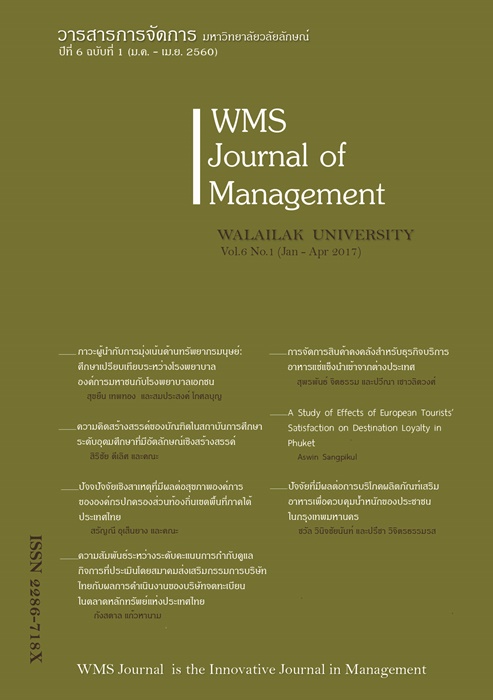Leadership and Human Resource Focus: a Comparative Study Between Autonomous Public Hospital and Private Hospital
Main Article Content
Abstract
Article Details
References
สถาบันพัฒนาและรับรองคุณภาพโรงพยาบาล. (2549). มาตรฐานคุณภาพโรงพยาบาล. สืบค้นเมื่อ 13 สิงหาคม 2556, สืบค้นจากhttp://www.ha.or.th/newweb/page02.php?id=143.
สำนักงานรางวัลคุณภาพแห่งชาติ. (2556). เกณฑ์รางวัลคุณภาพแห่งชาติ ปี 2555-2556.สืบค้นเมื่อ 13 สิงหาคม 2556, สืบค้นจาก http://www.tqa.or.th/th/TQAdownload.
สิทธิศักดิ์ พฤกษ์ปิติกุล. (2555). บริหารโรงพยาบาลสู่ความเป็นเลิศด้วย TQA. กรุงเทพฯ: ภาพพิมพ์.
สำนักงานคณะกรรมการพัฒนาระบบราชการ. (2549). รายงานผลการศึกษาพัฒนารูปแบบบื้องต้นของหน่วยงานภาครัฐ: องค์การที่มีขีดสมรรถนะสูง. สืบค้นเมื่อ 13 ตุลาคม 2556, สืบค้นจาก http://www.opdc.go.th/
oldweb/thai/High_Performance_Organize/
HighPerformanceOrganize.pdf.
Avolio, B., Walumbwa, F. & Webber, T. J. (2009). Leadership: Current Theories, Research, and Future Directions. Retrieved October, 16, 2013. From http://digitalcommons.unl.edu/cgi/viewcontent.cgi?article =1036&context =managementfacpub.
Bass, B.M. (1985). Bass & Stogdill’s Handbook of leadership: Theory, Research, & Managerial Applications. New York: Free Press.
Blaney, S. Bonnett, C. Caron, S. Kee, S. May, A. Norton, J. & Yardley, J. (2002). A Discussion Paper on Workplace Health. Retrieved August, 13 2013. From http://www.hthree.ca/Discussion_
Paper_20on_20Workplace_20Health.pdf.
Bou-Llusar, JC.Escrig-Tena, AB. Roca, V. &Beltrán, I. (2008). An empirical assessment of the EFQM Excellence Model: Evaluation as a TQM framework relative to the MBNQA Model. Operation Management Journal, 27, 1-22.
Day, V. D. & Antonakis, J. (2012). The Nature of Leadership. 2nd edition. London: Sage.
Fiedler, F. E. (1967). A theory of leadership effectiveness. New York: McGraw-Hill.
Fiedler, F. E. (1971). Leadership. General Learning. New Jersey: Morristown.
Hair, J.F. Black, W. C.Babin, B. J. & Anderson R. E. (2010). Multivariate Data Analysis: A Global Perspective. New Jersey: Pearson.
Jayamaha, N.P. (2008). Validity of Business Excellence Model: A Conceptual and Empirical Analysis. A Dissertation Submitted to Massey University, PalmerstonNort, New Zealand.
Koontz, H. O’Donnell, C. &Weinrich, H. (1980).
Management. 7th edition, Sydney: McGraw Hill.
Latham J. (2013). A Framwork for Leading the Transformation to Performance Excellence.The Quality Management Journal. 20(2), 12-33.
Nanjundeswaraswamy T S. & Swamy D R. (2012). A Literature Review on Quality of Work Life and Leadership Styles. International Journal of Engineering Research and Applications. 2 (3), 1053-1059.
Scouller, J. (2011). The Three Levels of Leadership: How to Develop Your Leadership Presence, Knowhow and Skill. Cirencester: Management Books.
Schruijer, S.G. L. &Vansina, L.S. (2002). Leader, Leadership and Leading: from Individual Characteristics to Relating in Context. Journal of Organizational Behavior. 23, 869-874.
Waal, A. (2007). The characteristics of a high performance organization. Business Strategy Series. 8(3), 179 - 185.


